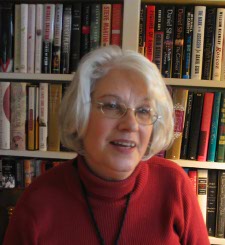Katherine Ashe’s four-book series portraying[dl1] Simon de Montfort was completed in September of 2011 when Montfort The Angel with the Sword was available for purchase. This concluded 34 years of research, writing, and traveling to the locales associated with Simon. The series was written under the “aegis of fiction” owing to gaps and rampant bias in the historical record, but the conclusions Ashe reached follow a logical and well-reasoned strand, her research taking on the flavor of an investigation. The paradox between Montfort’s traitorous reputation, negative accounts, and yet acknowledgments as pivotal in the founding of modern democratic government piqued Ashe’s interest
Every volume she read on Montfort in the US starting in 1977 contradicted each other so she traveled to the original source material at the British Library and the Public Record Office in London and the Bibliotheque Nationale in Paris. There she found items that provided new insights. Apparently, King Henry and his queen were experiencing miscarriages and needed an heir desperately. Nine months after Montfort visited the King and Queen at Kenilworth, the home of Montfort, the Queen delivered a lusty, healthy boy. The breach of friendship with King Henry was so sharp that Simon fled for his life and was in exile for four years.
Eventually, Ashe’s research was carried on at the Astor Tilden Lenox Library in New York where 19th-century reprints of a broad range of 13th-century documents widened her understanding of the period and the prejudices of Montfort’s contemporaries both for and against him. There was the entire world in which Montfort lived that needed to be understood. Ashe threaded her way not only through the period’s religious views, agriculture, economics, armor, and architecture (palatial, military, and vernacular.) In her words, “My research has been done almost entirely the old-fashioned way — going to the original sources as much as possible, and reading, and reading, and reading.”
Montfort is not a dry work of research, but a fast-paced story of adventure where Ashe’s 34 years of investigative research have resulted in sweeping, life-like scenes. She shares with readers the delight she experienced during her journey in a way that connects with her audience. She has critics, but her answers parallel the reasoned approach she takes in her novels; she answers with a dexterity, grace, and polish that few authors could replicate.
Many would ask why she would spend 34 years researching such an ambiguous individual and novelizing his life. But her reasons are quite simple: “My intent is not to write a definitive biography, but to rouse public interest in a man whose life truly changed the world — who has affected all of our lives up to the present, and well into the future as long as governments seek their authenticity through people’s elected representatives.”
visit Katherine Ashe at her author’s page on amazon.com to experience Simon de Montfort’s 13th-century world and visit her blog to learn more about Simon de Montfort.
Taken from an article written by Scott Higginbotham


I agree that Katherine Ashe’s writing is excellent and that she knows the period extremely well. I am surprised, though, that in all her 34 years of research she didn’t notice that Kenilworth was only granted to Simon de Montfort in February 1244 (Calendar of Patent Rolls 1232-1247, p. 419), and when Henry III (and perhaps Queen Eleanor, though I’ve never seen any evidence which definitively places her there) stayed at Kenilworth in September 1238, it was still a royal castle, not Montfort’s home. Matthew Paris says that Montfort returned to England from Italy on 14 October 1238, a month too late to conceive Edward I – and as Kenilworth was not yet his castle and wouldn’t be for more than five years yet, there’s no reason to suppose he would have been there with the king and queen anyway, even if he had been in England. As for Queen Eleanor’s tisane and prayers, perhaps she hadn’t yet realised she was pregnant pnly a few weeks along. For many reasons, I find it impossible to believe that Montfort could possibly have been Edward I’s natural father, and although it’s perfectly reasonable (if a little clichéd in modern historical fiction) to present him in as such in a work of fiction, to claim that it has a strong basis in fact is going much too far.
I know several people have asked Ms Ashe this same question recently, but I haven’t yet seen an answer: can she please tell me where the statute that made it a hanging offence to speak Montfort’s name is recorded? I have a copy of Statutes of the Realm 1100-1377, and it’s not in there.
“For many years it was considered a hanging offense in England to utter Simon de Montfort’s name”
I’ve seen this claim on Ms Ashe’s website and as the blurb for her book (I am currently reading book 1). But where on earth does it come from? If it were a “hanging offence” one would expect there would be records of people having been hanged for talking about Montfort. Or at least legislation prescribing it as such. I know of no such statute – you seem to have a good grasp of this era, can you help? When was it passed, and when was it repealed? Or is it just hyperbole, to overemphasise how Montfort became persona non grata?